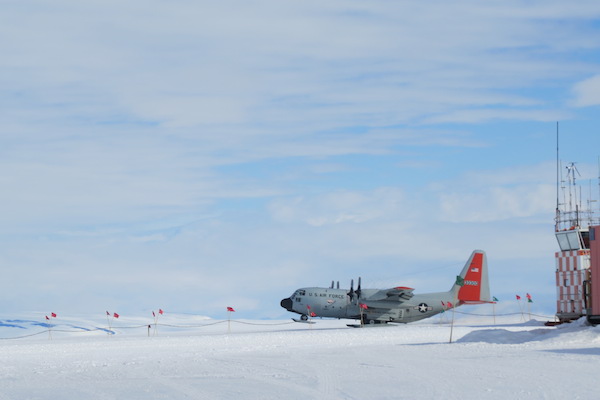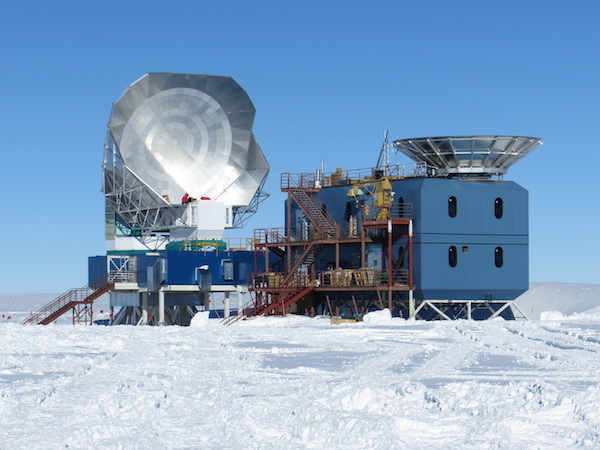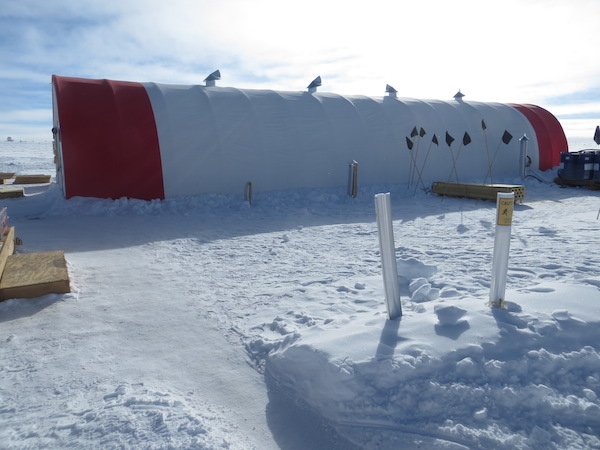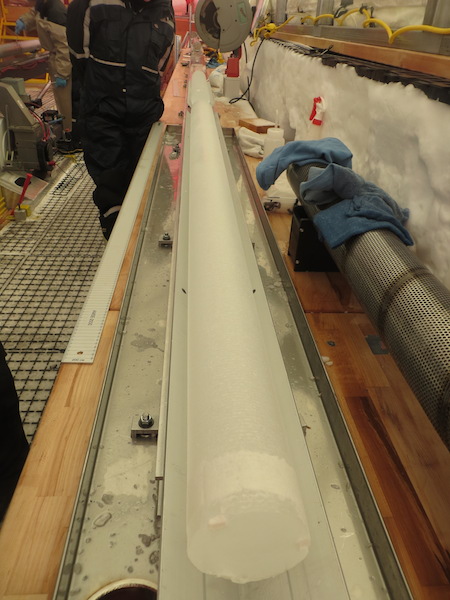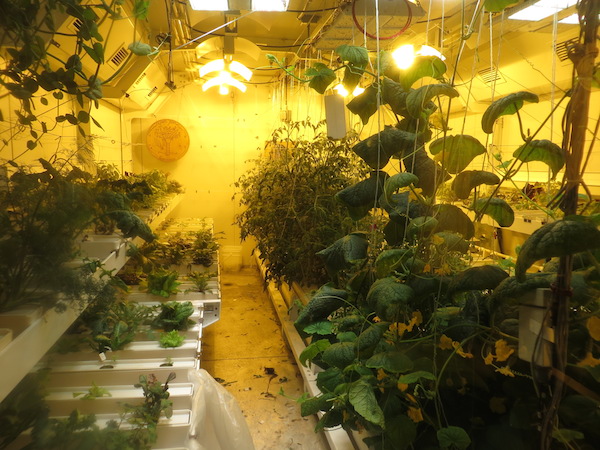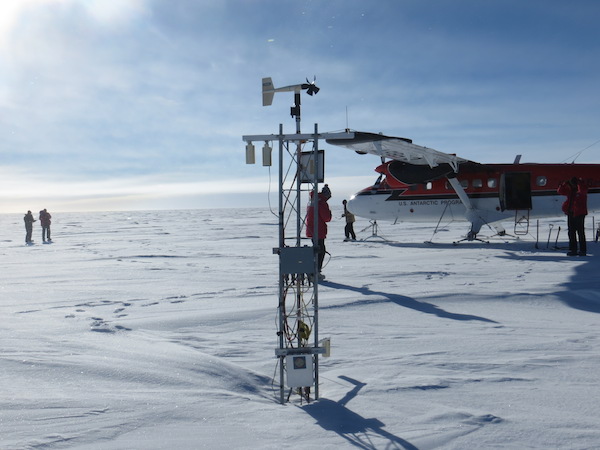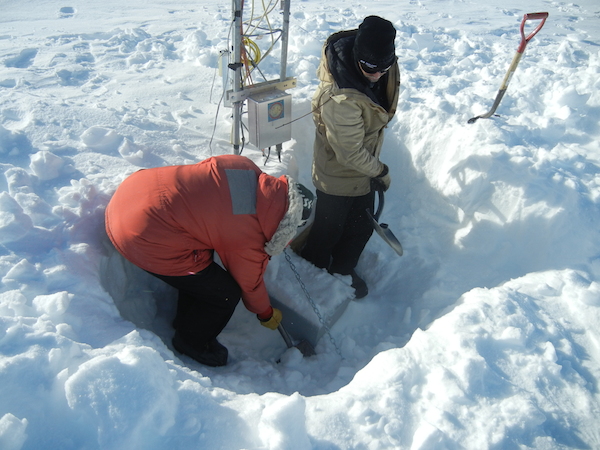As Carol said, I’ll be talking about a few more of the things we did while we were at South Pole, including our second and final station visit to Henry AWS. We were to do pretty much the same thing at Henry as Nico: replace the existing instrumentation and raise the station.
First (and I forgot to mention this to Carol for her to put in her post), some friends we met at Pole had a friend who took a picture of the LC-130 we all were on as we left McMurdo for South Pole on 5 January!
One of the first places we visited while we were awaiting a flight was the South Pole Telescope and other Astronomical/Cosmological Experimentation building(s).
There are several telescopes and projects going on. Carol and I spoke with some people who have instrumentation on the South Pole Telescope (SPT), and one guy has the Event Horizon Telescope (EHT, though the Telescope may not be in the name) instrument on it. They need to have a global network of instruments looking at the same point in the sky at the same time to be able to resolve the EH, because it is so small (fractions of an arcsecond [From Google: A second of arc (arcsecond, arcsec) is 1⁄60 of an arc minute, 1⁄3,600 of a degree, 1⁄1,296,000 of a circle, and π⁄648,000 (about 1⁄206,265) of a radian. This is approximately the angle subtended by a U.S. dime coin at a distance of 4 kilometres (about 2.5 mi).] !!!! ). Other telescopes that have this instrument are in Hawaii, California and Arizona.
Another telescope is BICEPS III, which they were finishing up building when we were there. When we went for the tour, they were calibrating the mount by recording the angle of the mount and noting which star was in the center of the screen. This way, when they scan the sky, they can document which stars are where and know where in the sky it is. This telescope, compared to BICEPS II, is able to see more “colors” (wavelengths) in the microwave part of the spectrum, so they can sort out what is noise and what isn’t in their data collection.
During another one of our off-days, Carol, Hans (a research assistant) and I visited South Pole Ice Core (SPICE Core).
We snowmobiled from the station to SPICECORE, with Hans driving and pulling Carol and I on a sled. (Hauling people in sleds on a snowmobile is a common mode of transportation at Pole.) The SPICECORE project is similar to that of the recent ice coring that took place in West Antarctica at WAIS. SPICECORE is drilling a hole deep within the ice sheet at South Pole and retrieving 2-meter-long ice core samples to be diagnosed back in the US.
We timed our visit just right, because when we arrived they were in the process of raising a core they had just drilled. We saw the drill come up from the hole and watched them remove the core from the bearings. They remove cores a couple meters in length at a time. They were ~420 m below surface then, and they hope to get to 700 m by the end of the summer. The ice core they removed is over 5000 years old!
South Pole Station also has a greenhouse. It is small, but has a small room with chairs, a couch and a table. It is a great place to hang out for a while and get some fresh smells of greenery and feel the humid air. I’m not sure if any of the plants are for research, but I do know that the chefs grow greens such as spinach and kale and use those for salads. No wonder the food is so good at Pole!
Once we were humidified, we were ready to get out into the field.
As Carol said, we finished Nico AWS successfully. The next day, Thursday 15 January, Carol and I flew to Henry AWS. As fate would have it (“fate” because originally a different Twin Otter crew was to fly us at Pole, but their plane had issues so they swapped crews in McMurdo), Henry Perk, who has been a Twin Otter pilot for about 30 years in Antarctica, was the pilot who flew some of our team members to initially install Henry AWS back in 1993!
Our field crew for that day also included 3 extra diggers: Hans Boenish (an aforementioned RA), Luke Magolda (works in cargo), and Corey Biddle (a surveyor). They were an excellent crew to have to help us out! Hans and Luke also took a lot of great pictures and video of our servicing, which was great because it wasn’t practical for Carol nor I to take such pictures.

The crew, from left to right: Hans, me, Carol, Corey, Luke (Picture taken after the visit. We all survived the cold!)
We arrived at Henry AWS at 8:45 am and got started with our work. The weather was quite pleasant for the beginning of the visit (air temperatures around -20 F, winds around 10 kts, wind chill around -40 F), but just as with Nico AWS, it would turn sour and cut our visit short.
We were pleasantly surprised to see how (relatively) tall Henry AWS was upon arrival:
We all got to work right away. I took initial pictures and instrument height measurements of the station, then Hans, Corey and Luke began digging while Carol set up the GPS and I looked through our instrumentation to start assembling mounts. It was then that I discovered that we didn’t have the mounting bracket kits to mount the ADG and solar pyranometer instruments on an instrument arm. I scoured our tool bag and the instrument case for any spare parts that could be used. I decided that I would worry about this later; by this time our diggers had already removed the existing enclosure and were beginning to remove two of the four existing batteries.
Once the digging was complete, we removed the old instrumentation and put on the new tower section. This is always interesting, as a lot of tugging, yanking, and some pounding is necessary to fit the new tower section on. Also, some high clouds started rolling in, and we could see that the horizon where the prevailing wind was coming from was starting to get washed out. White out conditions were approaching.
With the new tower section on, we then put the new power system with batteries into the bottom of the pit. This is a multi-person job as there were four batteries to put in one box, and each battery weighs 70 lbs. After that, the enclosure could be installed just below snow surface. As Carol mentioned, this is done to keep the ambient temperature around the enclosure near -50 F.
Now the rest of the instrumentation could be installed. At this point, I asked Corey if he could try and devise some mounting brackets for the ADG and pyranometer. While he was coming up with what turned out to be some great mounts using some parts from the old instrumentation, I installed the wind monitor.
Carol and I then tackled the rest of the instrumentation, with the help of Hans and Luke who installed the relative humidity sensor. We were at about 3 and a half hours of ground time, and Carol and I were installing the solar panel, when the co-pilot Dillon yelled up to Carol and I: “Whiteout conditions in 3 minutes! Better get done or you’re going to have to camp here!”
Our adrenaline starting pumping. We still needed to tighten the solar panel down, which was made more difficult because we both had been outside on the tower for a long time. Then I had to go plug all of the instruments into the enclosure and verify that the station turned on. Unfortunately, given our lack of time, we were not able to install the instrument boom with the ADG and pyranometer. We appreciated Corey’s hard work, but we weren’t able to put it to use.
Henry turned on the Otter engines to warm them up. I was at the bottom of the pit plugging in the instruments, with others holding shovels, eagerly waiting for me to finish so they could fill in the hole with snow. Dillon was loading cargo into the plane. The Otter engines were blasting in our ears, contributing to the haste of the situation. Whiteout conditions were creeping ever closer.
Everything was plugged in successfully, and we tried our best to fill in the hole as much as we could before jumping into the plane.
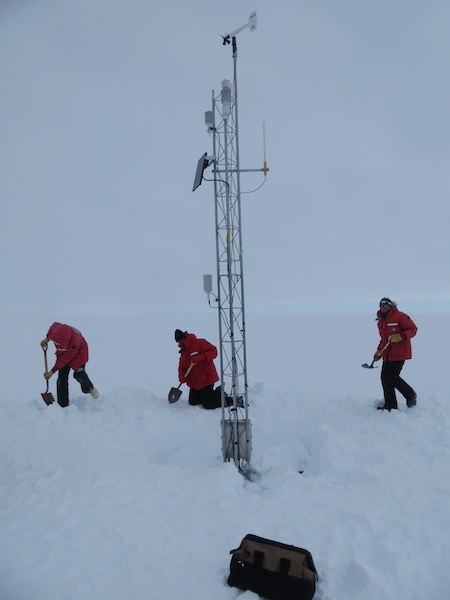
Henry AWS upon completion (almost). Carol, Corey and Hans fill in the pit with as much snow as they can.
It was an exciting end to our field work out of Pole. Lucky for us, we had a great pilot in Henry to fly us out of two tough situations in our visits to Nico and Henry AWS. To top it off, we have confirmed that both stations are transmitting nominally.
The following day, Friday 16 January, Carol and I left South Pole to head back to McMurdo. Considering we were waiting to do our work for 8 days, we were quite pleased to only have to leave Pole one day later than scheduled. This didn’t come without some stress though… The original herc (LC-130) flight that was flying from McMurdo was supposed to get into Pole at 1 pm. About 15 minutes before it was going to land, we heard an announcement on the PA system saying the herc boomeranged due to mechanical issues. Turns out, one of the four engines failed, so the herc had to go back to McMurdo. We didn’t end up leaving Pole until 10 pm that night. Either way, we were glad we didn’t have to wait more than a day!
Now we are back in McMurdo, working on sending retrograde cargo back to the US and planning our last few station visits. Will we be able to visit any more this season?…
Next time, with Dave and Carol.


